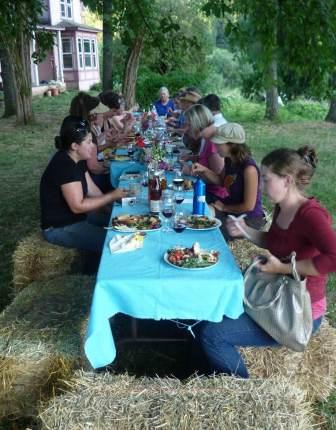Author: Melissa Fery, Small Farms Program, Oregon State University
Publish Date: Fall 12
The number of women farmers across the country is increasing. According to the 2007 census of agriculture, 30% of all farmers are women. Social stereotypes often portray farming women as “farmwives” rather than farm operators or decision-makers. Female operated farms tend to be smaller acreage and diversified, but with significantly less value of sales. Often, women farmers feel isolated from their peers. To address the unique needs of women farmers, the OSU Extension Service Small Farms Program has established regional women’s farm networks that are communities of practice.Three regional farmer networks in Oregon focus specifically on women producers: the League of Women Farmers (LOWF) is located in southern Oregon, the Willamette Women’s Farm Network (WWFN) serves four counties and is based in Corvallis and the North Willamette Women Farmer Network (NWWFN) covers the Portland metro area.
The networks function though facilitation by OSU Extension faculty and staff, but topics covered are decided by the membership. The networks have fostered peer mentorship and facilitated educational opportunities. Meetings or gatherings consist of farm tours, potlucks, discussions, and educational workshops. In addition, the networks have offered skill-building classes to women in activities typically conducted by male farm partners, including welding, fence building, tractor driving and carpentry. To date, over 350 women participate in the networks, activities and e-mail groups.Surveying the Women
Documented impacts of the program include the creation of mentoring relationships between new and seasoned farmers; increased exposure to niche and alternative marketing and production systems; and the development of collaborative relationships between members of the networks in marketing, production, equipment-sharing, and distribution.
In 2012, a comprehensive survey and needs assessment was completed with input from all three networks. Overall, the response rate was 44%. Individually for each network the response rates were WWFN – 63%, LOWF – 38%, and the NWWFN– 32%. There were 28 questions under three broad categories: Logistics and General Thoughts, Programming Needs and Demographics.
When asked what benefits the farmers received as result of being active in their women’s network, they responded:
1. More connection with farming community (85%)
2. Increased networking (77%)
3. Increased knowledge (73%)
4. Greater satisfaction with occupation/community (46%)
5. Developed farm skills (42%)
6. Increased customer base (12%)
The top two opportunities that are desired by network members are:
1. Farm walks to learn about different production systems (4.55 out of 5.0)
2. Informational/educational sessions (4.47 out of 5.0)
- Mechanical skills (welding, fence building, carpentry) 63.3%
- Farm accounting, recording keeping 62.2%
- Planning and building structures 58.7%
A majority of respondents (78%) are currently farming or ranching. Of those, 42 % of the respondents have been farming 1-4 years. The sizes of farms vary:
- Less than one acre 13%
- 1-5 acres 28%
- 6-15 acres 22%
- 16-30 acres 113%
- 30 or more acres 24%
Seventy percent are using direct/retail wholesale avenues to market their farm products and 38% are using farmers markets as one of the marketing strategies.
It is important to note that each of the Oregon women networks are unique and function differently based on their membership’s need and request.
Based on the success and impact of these networks, OSU Small Farms faculty will be traveling to three other states in the Northwest in 2013, to train agriculture professionals to develop women farmer networks.
Project collaborators: Melissa Matthewson, Maud Powell, Kristin Pool and Jen Cramer



